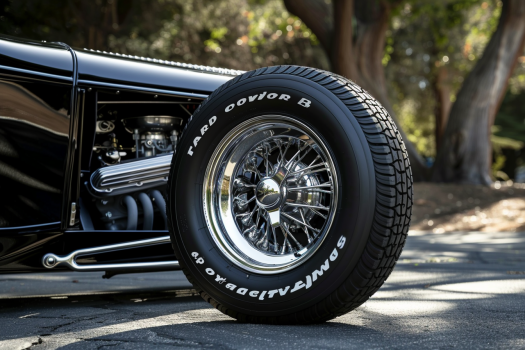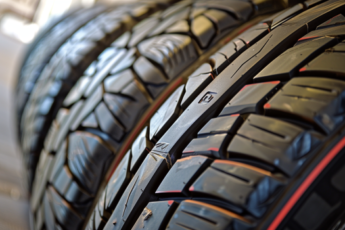Last Updated on 1 week
Tire White Lettering Design
Automotive design is a realm where functionality meets artistry, and nowhere is this blend more apparent than in tire design. The fascination with tire design stems from its unique engineering prowess and aesthetic appeal. One striking aspect of this design is the use of white lettering on tires, a feature that holds historical significance and contemporary allure.
Tire Design Fascination
Tire design, often overlooked in the broader context of automotive engineering, is rich in innovation and history. Its evolution mirrors the advancements in vehicle technology and road infrastructure. Initially designed purely for functionality, to provide traction and durability, tires have evolved into complex components that significantly impact the vehicle’s performance, safety, and aesthetics.
The fascination with tire design is not just about the rubber hitting the road; it’s about how these designs enhance vehicle performance. Tire tread patterns, for instance, are meticulously engineered to provide optimal grip in various weather conditions while minimizing noise and improving fuel efficiency. The sidewall’s construction, which can include layers of different materials, plays a crucial role in the tire’s load-bearing capacity and impact resistance.
Moreover, tire design has become a key element in the overall aesthetic appeal of vehicles. Car enthusiasts and manufacturers pay close attention to how tires complement the vehicle’s design. This attention to detail extends to the color, texture, and even the typography used on the tire’s sidewall, where white lettering comes into play.

White Lettering Overview
White lettering on tires is more than just a stylistic choice; it is a nod to the rich history of automotive culture. Initially, white lettering was a by-product of the manufacturing process, as early tires were made entirely of white rubber. However, with the advent of carbon black as a strengthening agent, tires took on their now-familiar black color, leaving the white lettering as a deliberate stylistic choice.
White lettering on tires was famous in the 1960s and 1970s, particularly in the muscle car and motorsports eras. White lettering became synonymous with performance and style, often seen on racing cars and high-performance vehicles. This style gave the tires a distinctive look, making the brand names and specifications more visible and recognizable.
Today, white lettering on tires is often associated with a retro or classic look, appealing to those who value nostalgia in automotive design. However, it’s not solely about looks; the white lettering can also be functional. It makes it easier to read important information about the tire, such as its size, type, and manufacturer, which can be crucial for maintenance and safety purposes.
The fascination with tire design and the specific trend of white lettering on tires highlight the intersection of functionality and aesthetics in automotive engineering. While seemingly small, this feature is a testament to the intricate details that go into vehicle design and the ongoing evolution of automotive culture. As we continue to innovate and push the boundaries of vehicle performance and style, elements like tire design and white lettering remain integral to the story of automotive progress.
Tire Lettering History
The history of tire lettering is a fascinating journey that intertwines with the automotive industry’s evolution. From the early origins of tire markings to the advanced lettering techniques of today, each step in this history reflects broader technological and cultural shifts.
Origins of Tire Markings
The story of tire markings begins in the late 19th and early 20th centuries. The earliest tires were made from natural rubber, which was inherently white. These tires were used primarily on bicycles and the first automobiles and had no specific markings or branding. As the automotive industry grew, the need for more durable and robust tires led to significant tire composition and design changes.
The introduction of carbon black as a reinforcing agent in tire manufacturing during the early 1900s was pivotal. This substance significantly improved the tire’s durability and performance when added to the rubber compound. It also gave the tires their now-characteristic black color. However, this transition to black tires also made it challenging to include visible markings or branding on the tire’s surface.
Recognizing the need for distinguishable branding and information on tires, manufacturers began experimenting with various marking techniques. The earliest tire markings were simple, often including only the manufacturer’s name or essential information. During manufacturing, these markings were embossed or molded directly into the tire’s sidewall.
Lettering Techniques
As the automotive industry evolved, so did the techniques for tire lettering. The primary goal was to make the lettering durable and visible, even under harsh driving conditions. One of the earliest methods involved raising letters on the tire’s sidewall. This was achieved by designing the tire mold with the lettering in reverse, so when the tire was manufactured, the letters would protrude from the sidewall.
White lettering became popular in the 1960s and 1970s, especially on high-performance and racing tires. This style was achieved by applying a white rubber compound to the raised letters. The contrast between the white letters and the black tire made the lettering more visible and added a distinctive style element to the tire.
The process of applying white lettering has evolved over the years. Initially, white lettering was added to the tire by placing a thin layer of white rubber compound in the mold before adding the black rubber. This method ensured that the white lettering was integral to the tire and not just a surface application. Modern techniques include using durable, high-contrast paints and more advanced rubber compounds that maintain the lettering’s visibility and integrity over the tire’s lifespan.
In recent years, tire lettering has become more sophisticated, with the ability to include detailed logos, intricate designs, and even custom text. This is mainly due to advancements in tire manufacturing technologies and materials, allowing for greater precision and creativity in tire design.
The history of tire lettering is a testament to the continuous innovation in the automotive sector. From the earliest embossed markings to the modern, highly stylized lettering, each development reflects a combination of practical necessity and aesthetic consideration. As tire technology advances, tire lettering will evolve, blending heritage with modernity in the ongoing story of automotive progress.
Visual Impact
The visual impact of tire design, mainly white lettering on black rubber, is a subject of aesthetic appreciation and practical consideration in the automotive world. This chapter delves into the intricacies of ‘White on Rubber Aesthetics’ and how ‘Lettering Influences Vehicle Looks,’ exploring the subtle yet significant role tire appearance plays in the overall visual appeal of vehicles.
White on Rubber Aesthetics
The stark contrast of white lettering against black rubber is not just a stylistic choice; it’s a design element that speaks volumes about the vehicle’s character. The use of white lettering on tires can be traced back to the early days of the automotive industry, but during the 1960s and 1970s, this feature gained prominence, especially in the realm of performance and racing cars.
The aesthetic appeal of white lettering on tires lies in its ability to highlight brand identity and model specifications in a visually striking manner. It creates a focal point on the tire, drawing attention to the craftsmanship and design details. The choice of font, size, and styling of the lettering can significantly influence the tire’s visual impact. For instance, bold and angular fonts tend to convey a sense of aggression and performance, aligning with the characteristics of sports and racing vehicles.
This contrast is not just about color; it’s about creating a visual balance between the tire and the vehicle. The white lettering can complement or accentuate the vehicle’s color scheme and design lines, contributing to a cohesive and well-thought-out appearance. In custom vehicles and show cars, white lettering is often used to match or contrast design elements, such as pinstriping or vehicle graphics.
Lettering and Vehicle Looks
The influence of tire lettering on the overall look of a vehicle is substantial. Tires are not merely functional components; they are an integral part of a vehicle’s aesthetic identity. The choice of tire design, including the presence or absence of white lettering, can alter the vehicle’s perceived style and character.
In luxury and classic vehicles, white lettering can add a touch of elegance or nostalgia reminiscent of the vehicle’s heritage or the era it represents. For modern performance cars, white lettering on tires often signifies a focus on speed and power, echoing the vehicle’s dynamic capabilities.
Furthermore, tire lettering visibility is crucial in brand recognition and marketing. A prominent display of the tire manufacturer’s name and model is a branding tool and a mark of quality and prestige. It’s a subtle endorsement, suggesting that the choice of tires is as important as the choice of the vehicle itself.
In the aftermarket and customization scene, white lettering on tires allows for personalization and expression. Enthusiasts often use custom lettering to add a unique touch to their vehicles, showcasing their style or affiliations with car clubs or brands.
The visual impact of white lettering on tires is a multifaceted aspect of automotive design. A blend of aesthetics, branding, and personal expression contributes significantly to a vehicle’s overall appearance and character. As automotive design continues to evolve, the role of tire lettering in shaping vehicle aesthetics remains a dynamic and integral element, reflecting the continuous interplay between form and function in the automotive industry.
Brands and Lettering
In the realm of tire manufacturing, the use of white lettering has evolved into a powerful branding tool. This chapter explores how brands use white letters for branding purposes and examines the styles of iconic brands that have become synonymous with this design choice.
Branding with White Letters
White lettering on tires is more than just an aesthetic choice; it’s a strategic branding decision. Tire manufacturers use white lettering to increase brand visibility and recognition. This practice has roots in the early days of automobile racing, where tire brands sought to stand out in the highly competitive market. The distinctive white lettering on the dark rubber made the brand names on tires easily recognizable, both on and off the race track.
The effectiveness of white lettering in branding can be attributed to its high visibility and contrast against the black tire. This visibility ensures that the brand name and tire model are immediately noticeable, helping to build brand recognition and loyalty among consumers. This is an essential aspect of marketing for tire manufacturers, as it turns every vehicle into a moving advertisement for their products.
Moreover, the style and font used in the white lettering have become part of the brand’s identity. Each tire brand has its unique font style that reflects its brand image. For example, a brand known for performance tires might use bold and dynamic fonts to convey speed and strength, while a brand focusing on luxury vehicles might opt for elegant and sophisticated lettering.
Iconic Brands’ Styles
Several tire brands have become iconic, partly due to their distinctive use of white lettering. These brands have leveraged the stylistic element of white lettering to create a unique identity that resonates with their target audience.
One of the most iconic examples is Goodyear. Known for its involvement in motorsports, Goodyear’s white lettering is synonymous with performance and quality. The font used by Goodyear is recognizable and has become a symbol of the brand’s heritage in racing and automotive excellence.
Another notable example is Firestone, a brand with a deep history in the automotive industry. Firestone’s use of white lettering has a classic and timeless appeal, reflecting the brand’s long-standing reputation for durability and reliability.
Michelin is yet another example. The brand is known for its premium-quality tires. The brand’s white lettering is more subtle and sophisticated, aligning with its positioning as a high-end tire manufacturer.
These iconic brands have used white lettering not just for its visual appeal but also as a tool for storytelling. The lettering style, placement, and design speak volumes about the brand’s history, values, and market position.
Using white lettering in tire branding is a strategic choice with significant brand identity and recognition implications. Iconic brands have successfully used this design element to distinguish themselves in a competitive market, creating an instantly recognizable visual signature. As the tire industry evolves, using white lettering as a branding tool remains vital to a brand’s visual identity and marketing strategy.
The Science Behind Durable White Tire Lettering
Applying white lettering on tires is an aesthetic choice and a material science feat that combines durability and visibility. This chapter delves into the composition and durability of tire lettering, revealing the technical intricacies behind what might seem like a simple design element.
Lettering Composition
The composition of tire lettering is a complex process involving materials that can withstand extreme conditions. Traditionally, tire lettering was made using the same rubber compounds as the tire but with added pigmentation to achieve the white color. However, this method had limitations regarding the durability and brightness of the white color.
Modern advancements have led to the use of specialized paints and rubber compounds that are designed explicitly for tire lettering. These materials are formulated to be highly resistant to UV rays, road chemicals, and varying weather conditions, ensuring that the lettering remains vivid and intact over time.
One standard method for creating white lettering on tires is using a durable, high-contrast paint. This paint is applied to the raised letters on the tire’s sidewall. The key is to use a paint that adheres well to the rubber, resists fading, and can handle the flexing and heat generated by the tire in motion.
Another approach is to incorporate white lettering into the tire during manufacturing. This involves placing a thin layer of a white rubber compound in the tire mold before adding the black rubber. The white layer becomes an integral part of the tire, ensuring the lettering is as durable as the tire itself.

Lettering Durability
The durability of tire lettering is crucial, as tires are subject to harsh operating conditions, including exposure to sunlight, heat, road debris, and various chemicals. The lettering must withstand these conditions without peeling, cracking, or fading.
One critical factor in the durability of tire lettering is the quality of the materials used. The pigments in the white rubber or paint must resist fading due to UV exposure. Additionally, the bonding agents in the paint or rubber must be strong enough to maintain adhesion to the tire’s surface throughout its life.
Manufacturers also conduct extensive testing to ensure the durability of the lettering. These tests simulate long-term wear and environmental exposure to guarantee that the lettering will remain legible and aesthetically pleasing for the tire’s life.
Durability is a significant concern in the aftermarket, where custom tire lettering is famous. High-quality kits that use materials similar to those used by tire manufacturers are available. These kits allow for custom lettering while maintaining the necessary durability.
The material science behind tire lettering is a sophisticated field that plays a crucial role in the longevity and effectiveness of this design feature. Whether integrated during the tire manufacturing process or applied aftermarket, tire lettering’s composition and durability require careful consideration of materials and application techniques. This attention to detail ensures that the white lettering on tires remains a striking and lasting element of automotive design.
The Role of the Racing World and Media Impact
The prominence of white lettering on tires in the racing world and its portrayal in various media forms have significantly shaped public perception and trends in tire design. This chapter explores how the world of racing and the influence of media have contributed to the popularity and perception of tire lettering.
Racing World’s Influence
The connection between white lettering on tires and the world of racing is deep-rooted and significant. Historically, white lettering on tires became popular in the 1960s and 1970s, when motor racing was popular. This era saw the rise of muscle cars and high-performance vehicles on the track and streets.
In the racing arena, white lettering on tires served a practical purpose: it provided high visibility for brand names and tire specifications at high speeds. Major tire manufacturers, such as Goodyear, Firestone, and Michelin, utilized this feature for branding purposes and to showcase their involvement and success in motorsports. The visibility of these brands on race tracks around the world contributed to their prestige and desirability in the consumer market.
The association of white-lettered tires with speed, performance, and racing pedigree created a perception of these tires as high-performance options. This perception has endured, with white-lettered tires often PD for performance and sports car enthusiasts who wish to emulate the racing look and feel.
Media Impact
The portrayal of white-lettered tires in various forms of media has further cemented their status in popular culture. From movies and television shows to advertisements and automotive magazines, white-lettered tires have been prominently featured, often on high-performance or iconic vehicles.
In film and television, white-lettered tires are frequently seen on cars depicted as powerful, fast, or linked to a character with a strong presence. This consistent association in media has reinforced the connection between white lettering and performance in the public’s mind.
Automotive advertising and marketing campaigns have also popularized white-lettered tires. These campaigns often highlight the tires’ aesthetic appeal, using imagery conveying speed, power, and sophistication. The media’s portrayal of these tires as a symbol of performance and style has influenced consumer preferences, leading to a demand for them in the aftermarket and customization scenes.
The influence of the racing world and media on the popularity and perception of white-lettered tires cannot be understated. The historical association of these tires with high-performance racing and their consistent portrayal in the media as symbols of speed and style has significantly shaped their role in automotive culture. As a result, white-lettered tires continue to be a popular choice for those looking to add a touch of performance and prestige to their vehicles.
Consumer Perspectives
The role of consumer perspectives in shaping the trends and acceptance of tire lettering is pivotal. This chapter delves into public opinions regarding tire lettering and the emerging design trends influenced by these perspectives. Understanding these aspects provides insights into the broader implications of tire aesthetics in the automotive world.
Public Opinions on Lettering
Public opinion on tire lettering varies widely and is influenced by cultural preferences, automotive trends, and individual tastes. Generally, there are two camps: enthusiasts who appreciate the aesthetic and nostalgic value of white-lettered tires and those who prefer a more minimalist, traditional black tire.
Enthusiasts often view white lettering as a stylistic nod to the golden era of muscle cars and motorsports. For them, it’s not just about the look; it’s about what the style represents—speed, power, and a rich automotive heritage. This demographic tends to be more engaged in automotive culture, often participating in car shows, races, or clubs.
On the other hand, some consumers view white lettering as outdated or too flashy. They prefer the sleek, uninterrupted look of a black sidewall, often perceived as more modern and less distracting. This group might include those who prioritize a vehicle’s contemporary design or view cars more as utilitarian objects than as expressions of personality or history.
Social media and online forums play a significant role in shaping these opinions. Automotive enthusiasts often share and discuss their preferences on these platforms, influencing public perception and trends. Additionally, customer reviews and feedback on tire manufacturer websites also provide insight into consumer preferences and experiences with different styles of tire lettering.
Design Trends
Tire lettering design trends are closely tied to broader automotive trends and consumer preferences. In recent years, there has been a resurgence in the popularity of white-lettered tires, partly due to the revival of retro and classic styles in the automotive industry. This trend is evident in the increasing number of car manufacturers offering white-lettered tires as an option on new models, particularly those with a sporty or nostalgic design.
Customization also plays a significant role in design trends. With the availability of aftermarket tire lettering kits, consumers can personalize their vehicles to their liking. These kits allow for a range of customization, from different fonts and colors to adding custom text or logos. This trend towards personalization reflects a growing desire among consumers to make their vehicles unique.
Sustainability and environmental consciousness are also influencing tire design trends. As consumers become more environmentally aware, there is a growing interest in aesthetically pleasing tires made from sustainable materials. Tire manufacturers are responding to this demand by exploring more eco-friendly materials for tire production, including the materials used for lettering.
Consumer perspectives play a critical role in shaping tire lettering trends and acceptance. While opinions on this design element vary, its impact on the automotive world is undeniable. From enthusiasts who cherish the style for its historical significance to those who view it as an opportunity for personalization, tire lettering continues to be a topic of interest and debate among consumers. As automotive trends evolve, so will the styles and preferences surrounding tire lettering, reflecting the ever-changing consumer tastes and values landscape.
Functional Benefits and Importance of Style in Tire Lettering
In the world of automotive design, the debate between style and function is ever-present, and tire lettering is no exception. This chapter explores the functional benefits and the significance of class in tire lettering, offering insights into how these aspects influence consumer choices and manufacturer designs.
Functional Benefits
At first glance, tire lettering might seem purely decorative, but functional benefits exist. One of the primary active roles of tire lettering is conveying important information. The raised white lettering on tires typically includes details such as the tire size, type, speed rating, and manufacturer. This information is crucial for proper tire maintenance and safety.
Visibility is another functional aspect. In certain situations, particularly in motorsports, the high contrast of white lettering against the black rubber makes it easier to quickly identify tire specifications and brand names, even from a distance or at high speeds. This aspect can be vital during racing events where quick tire assessments are necessary.
Moreover, the durability of the lettering itself has functional implications. High-quality, durable lettering that resists fading, peeling, or wear ensures that the tire information remains legible throughout the tire’s lifespan. This longevity is vital in providing continuous visibility of tire specifications for safety and maintenance.
Style Importance
While the functional benefits are clear, tire lettering’s style aspect is significant in the automotive world. In this context, style is not just about aesthetics; it’s about identity and culture. White-lettered tires have a solid historical and cultural significance, especially in specific car communities. They evoke a sense of nostalgia and are often associated with the classic era of muscle cars and the golden age of motorsports.
The stylistic choice of white lettering can also be a statement of personal taste. For car enthusiasts, customizing a vehicle with white-lettered tires is a way to stand out, reflecting individual style and personality. This form of personal expression is a critical element of the car culture, where the appearance of a vehicle can be as important as its performance.
Tire manufacturers and car brands often use white lettering as a differentiator in the broader automotive market. It can add a sporty or premium look to a vehicle, influencing consumer perceptions and appeal. For some models, especially performance or limited edition cars, white-lettered tires are part of the overall design package, enhancing the vehicle’s aesthetic and brand identity.
The debate between style and function in tire lettering is not one versus the other; instead, it’s about how these aspects coexist and complement each other. While the functional benefits of tire lettering are undeniable, its stylistic significance plays a substantial role in automotive culture and consumer preferences. As the automotive industry continues to evolve, the interplay between style and function in tire lettering remains a dynamic and influential factor in vehicle design and consumer choice.
Challenges and Debates
While aesthetically pleasing and culturally significant, adding white lettering to tires has challenges and debates. This chapter delves into the environmental and safety concerns of tire lettering and the ongoing discussions surrounding its regulation.
Environmental and Safety Issues
The environmental impact of tire lettering arises primarily from the materials and processes used in its application. Traditional methods of creating white lettering on tires involve using paints and rubber compounds that may contain volatile organic compounds (VOCs) and other potentially harmful chemicals. These substances can have environmental implications during the manufacturing process and the tire’s life cycle.
VOCs, for example, can contribute to air pollution and have been linked to various environmental and health issues. Applying these materials to tires raises concerns about waste and energy use, particularly if additional steps or resources are required.
Regarding safety, the primary concern revolves around the durability and integrity of the lettering. If the materials used for the white lettering degrade or peel off over time, they could potentially contribute to microplastic pollution. Moreover, there are questions about whether applying lettering materials may compromise the tire’s structural integrity. However, little evidence suggests a significant impact in this regard.
Regulation Discussions
Regulatory discussions concerning tire lettering tend to focus on environmental and safety aspects. On the ecological front, regulations may target the reduction of harmful chemicals in tire manufacturing, including those used in tire lettering. This has increased interest in eco-friendly tire lettering alternatives, such as water-based paints or sustainable rubber compounds.
Safety regulations, however, are primarily concerned with ensuring that tire lettering does not adversely affect tire performance. This includes ensuring the lettering does not create imbalances in the tire or weaken its structure. Regulatory bodies may also require that the lettering remains legible over the tire’s lifespan, as it often contains important information regarding tire specifications and safety.
The tire industry and regulatory agencies are increasingly focused on balancing the desire for stylistic customization with environmental and safety considerations. This has prompted ongoing discussions and research into new materials and technologies to provide the desired aesthetic appeal of tire lettering while minimizing environmental impact and maintaining tire safety.
The challenges and debates surrounding tire lettering are complex, encompassing environmental, safety, and regulatory dimensions. As the automotive evolves, addressing these concerns will ensure that tire lettering remains a viable and responsible choice for manufacturers and consumers. The ongoing discussions and developments in this area reflect a broader trend towards more sustainable and safety-conscious automotive design and manufacturing practices.
Future of Tire Design
The future of tire design promises to be an exciting fusion of aesthetic innovations and technological advancements. As the automotive industry continues to evolve, tire design and functionality are expected to undergo significant transformations. This chapter explores potential aesthetic innovations in tire design and offers predictions about future trends and developments.
Aesthetic Innovations
In tire aesthetics, the focus is shifting towards more sustainable and advanced materials that offer style and functionality. One area of innovation is the development of eco-friendly materials for tire production, including the lettering. These materials aim to reduce environmental impact without compromising on the visual appeal of the tires.
Another emerging trend is the use of intelligent technologies in tire design. This could include integrating color-changing materials or electronic displays within the tire’s surface, allowing for dynamic and customizable appearances. Such technologies enable real-time information display (like tire pressure or wear indicators) directly on the tire’s sidewall, combining aesthetics with practical functionality.
The concept of 3D-printed tires is also gaining traction, offering unprecedented levels of customization in tire design. With 3D printing, consumers could design their tire patterns and lettering, choosing from various textures, colors, and materials to suit their preferences and driving needs.
Design Predictions
The realm of tire design is poised for a period of significant transformation. This metamorphosis transcends mere functionality, venturing into aesthetics, personalized experiences, and environmental responsibility.
One key trend is the burgeoning integration of tires into the holistic design concept of vehicles. Tires will no longer be viewed as an afterthought but as a critical element contributing to the car’s overall visual appeal and functional performance. This paradigm shift will likely necessitate closer collaboration between tire manufacturers and automotive designers, fostering the creation of a more harmonious and unified aesthetic.
Furthermore, the future beckons with an increased demand for customizable and adaptive tire designs. As consumer interest in personalized vehicles intensifies, the ability to tailor tires’ appearance and performance characteristics will emerge as a crucial selling point. This trend might translate into the development of easily interchangeable tire skins or surfaces, empowering drivers to modify the visual character of their tires swiftly.
Sustainability will undoubtedly remain a dominant force shaping tire design. Tires of the future will likely be crafted from materials with a reduced environmental footprint and engineered for extended lifespans. This focus on sustainability will also influence the aesthetic language of tires, with designs that embody an eco-conscious philosophy.

Conclusion & Recommendations
As we conclude our exploration into the intriguing world of tire design, mainly focusing on the mystery and allure of white lettering, it’s clear that this feature is more than just a stylistic choice. It’s a blend of history, culture, and innovation deeply rooted in the automotive world.
Decoding the White Lettering Mystery
The journey of white lettering on tires from its practical origins in the racing sector to its resurgence as a retro-style icon is a testament to the dynamic nature of automotive design. Initially serving the purpose of brand visibility and recognition in the high-speed world of motorsports, white lettering has evolved into a symbol of performance and heritage. This evolution reflects the broader trends in the automotive industry, where the merging of function and fashion is increasingly prevalent.
The sustained popularity of white-lettered tires, despite the advent of newer designs and technologies, highlights a consistent desire for a touch of classic flair. It speaks to the enduring appeal of designs that pay homage to the golden eras of automotive history while still aligning with modern aesthetics.
Reflections on Design Trends
Reflecting on the current trends in tire design, it’s evident that personalization and sustainability are becoming increasingly important. Consumers today seek options that enhance the look of their vehicles and resonate with their values, be it environmental responsibility or a nod to automotive history.
The automotive industry is responding to these consumer preferences with innovations in materials and design. Integrating advanced technologies and eco-friendly materials in tire manufacturing responds to environmental concerns and offers an opportunity to redefine what tires can provide in terms of performance and aesthetics.
Recommendations
For those intrigued by the charm of white-lettered tires or looking to make a statement with their vehicle, the key is to balance style with functionality. Consider the overall look of your car and how white-lettered tires would complement or enhance its appearance. Also, be mindful of the maintenance and durability of these tires, as their aesthetic appeal should not come at the cost of performance and safety.
For car enthusiasts and consumers looking to explore a wide range of tire options, including those with white lettering, GigaTires offers an extensive collection to suit various preferences and needs. With a focus on quality, durability, and style, GigaTires ensures that your tire choice aligns with your vehicle’s requirements and taste.
As you consider updating your vehicle’s tires, remember that they are more than just a functional necessity; they are a statement of your style and a reflection of your driving experience. Visit GigaTires to discover a world of options that bring together the best in tire technology and design aesthetics. Whether you’re drawn to the classic appeal of white-lettered tires or prefer a more modern look, you’ll find a selection that meets your performance, style, and value expectations.
Explore Our Collection at GigaTires
FAQs
What is the historical significance of white lettering on tires?
White lettering on tires dates back to the early days of tire manufacturing. Initially, it resulted from the natural color of rubber and later became a style statement in the 1960s and 1970s, particularly in motorsports and muscle cars.
Why do only some tires have white lettering?
White lettering on tires is often a design choice made by manufacturers to create a distinctive or classic look commonly associated with performance and sports vehicles. It also serves branding purposes, making the tire brand more visible.
How is white lettering applied to tires?
White lettering can be applied to tires using various methods, including using durable, high-contrast paints or embedding a white rubber compound into the tire during manufacturing.
Does white lettering on tires have any functional benefits?
While primarily aesthetic, white lettering can make it easier to read important information on the tire, such as size and type, which can be helpful for maintenance and safety purposes.
Can I add white lettering to tires that don’t initially have it?
White lettering can be added to tires using aftermarket kits. These kits allow for customization, but ensuring the materials used are durable and suitable for the specific tire type is essential.
How does white lettering affect the overall appearance of a vehicle?
White lettering on tires can significantly enhance a vehicle’s appearance, giving it a more distinctive, sporty, or retro look. It can accentuate the vehicle’s design and is often favored by car enthusiasts for its classic appeal.
Are there any special care requirements for tires with white lettering?
Tires with white lettering may require additional maintenance to keep the lettering clean and visible. Regular cleaning to remove dirt and grime and using specific tire cleaning products can help maintain their appearance.
Why do white letter tires come blue?
White letter tires often have a protective blue coating to prevent discoloration and damage during shipping and storage. This coating is designed to be washed off easily before installation, revealing the clean, white lettering underneath.
How do you permanently mark a tire?
Use a tire paint pen or a specialized tire lettering kit to mark a tire permanently. These products are designed to adhere to the rubber, withstand harsh conditions, and maintain the marking’s visibility and durability over time. Cleaning the tire surface thoroughly before application ensures the marking lasts.










